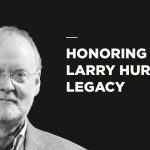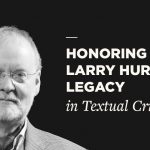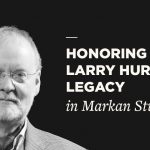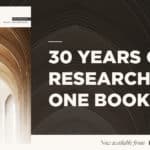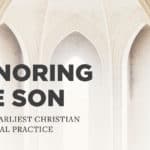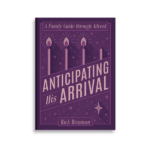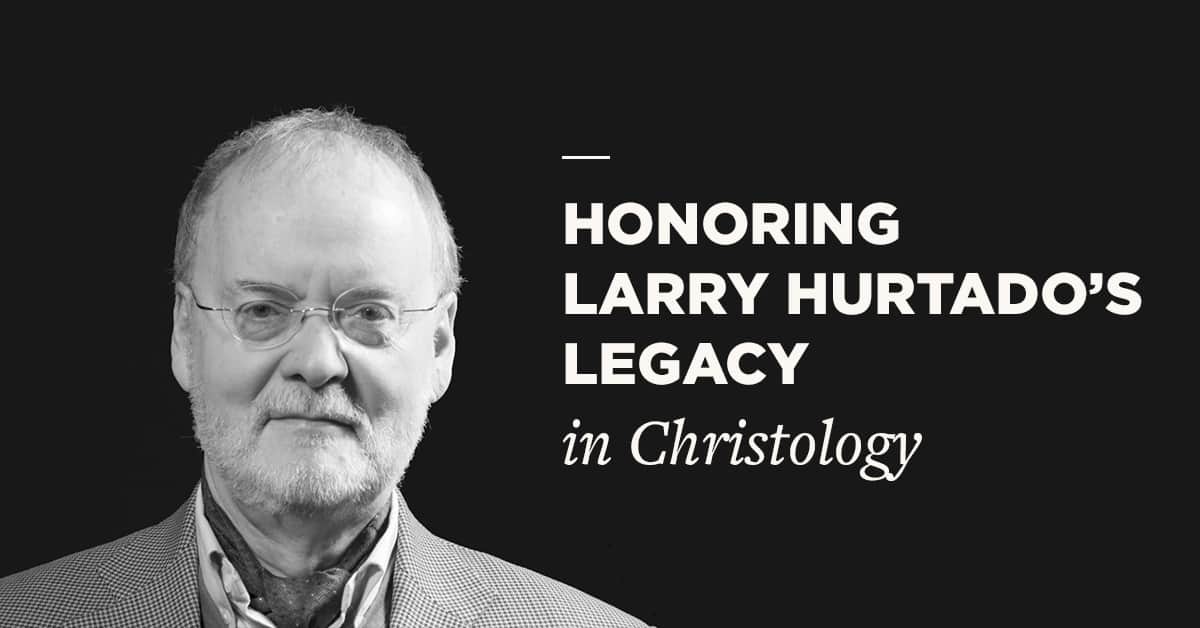
This week, in remembrance of his death nearly one year ago, Lexham Press will be running a series of blog posts honoring Larry Hurtado’s legacy and contributions to biblical scholarship. This first post was written by Chris Tilling.
I entered the room and sat opposite Professor Larry Hurtado, who had already placed his file on the table. My eyes were fixed on him, much as my six-year-old boy might stare if Thomas the Tank Engine had just chugged into view. I had not met him before, but his reputation, let us say, preceded him. I was a green-behind-the-ears student about to undertake my PhD viva, which would decide whether I were to become “Dr. Tilling” or not. So, no pressure. My own work, which I was about to defend, drew extensively upon Hurtado, while also appreciatively developing beyond his major contributions. What would he make of it? I had no idea! But one thing was certain: what he thought mattered. Indeed, it mattered a lot to me. For in my own field, that of early Christology, no name rivals his. Certainly, Richard Bauckham was just as important in terms of scholarly fruitfulness, but Hurtado, the year I began my doctoral work, had published the seminal work in my field: Lord Jesus Christ. This book demonstrated Hurtado at his finest. He wrote extensively, carefully and with a full command of the scholarship, and we will return to this book below. Agree or disagree with his conclusions, his work was a must-read, a mountain range over which one had to climb. To ignore Hurtado would have been like ignoring the works of Martin Luther in an account of “justification.”
So there was I, sitting at a table trying to gather my courage, a junior doctoral candidate before a scholarly celebrity—a role model, if you will, of energetic, careful, hard work. What would he make of my arguments, my exegetical proposals, my method? Well, the ensuing discussion and ongoing set of disagreements is a story for another day. But hopefully this picture begins to paint something of this man’s stature. “Towering” about nails it.
In the world of early Christology, Hurtado’s authority was stamped by two major contributions: One God, One Lord, and the aforementioned Lord Jesus Christ. But he was a prolific author. In addition to these, he also made important contributions in discussions about early Christology in two more monographs, namely At the Origins of Christian Worship and How on Earth Did Jesus Become a God? Toward the end of his work on the question of Christology, he also penned God in New Testament Theology, drawing out in more detail what was already in nuce in his earlier works, and a useful summary of some of his key contributions can be found in Honoring the Son. What is more, he published numerous important essays, all of which were must-reads for those engaging questions about the identity of Jesus for the first Christians. Particularly helpful, to my mind, were “What Do We Mean by ‘First Century Jewish Monotheism’?” (1993), “First-Century Jewish Monotheism” (1998), “Pre-70 C.E. Jewish Opposition to Christ-Devotion” (1999), and “The Binitarian Shape of Early Christian Worship” (1999), but others could be mentioned. I read them all, of course. As a result, Hurtado profoundly shaped my thinking, as well as that of most scholars engaged in discussions about early Christology. In what ways? Well, here are four key ways Hurtado left a legacy in the scholarship of early Christology.
First, Hurtado was one of the pioneers in developing what was memorably dubbed by the great Martin Hengel (1926–2009) as “a new Religionsgeschichtliche Schule” (“history of religions school”). Around the beginning of the twentieth century, Wilhelm Bousset—the most important member of this “school”—published a landmark study, Kyrios Christos (1913). Bousset’s contributions set the stage for later discussion in at least three ways. (1) He focused on the religious experience of the first Christians to say something about early Christology—this is the Religion aspect. (2) He compared this religious experience with similar documented Greco-Roman pagan experiences—this is the history part. And (3), he presented a wide-ranging chronological account of early Christology that started with the first Christ-followers and swept through to Irenaeus.
So important was Bousset’s work that Douglas Campbell can write the following, when framing my own contribution to this field in a foreword to Paul’s Divine Christology: “Our sketch can begin with Wilhelm Bousset. It will be uncontroversial to suggest that the work of Bousset has cast a long shadow over the analysis of Paul’s Christology in the modern period.” Indeed so. In this light, one can better appreciate the monumental contributions offered in Hurtado’s Lord Jesus Christ, which in many respects aimed to replace Wilhelm Bousset’s Kyrios Christos.
Although Hurtado also sought to generate a historical account of developments from the first Christ-followers to the end of the second century AD, he differed from Bousset in two crucial respects. Hurtado did not draw parallels between early Christian piety and Greco-Roman sources. Rather, he drew attention to Second Temple Jewish texts, on the one hand, and primarily early Christian cultic and communal practices, on the other. Hurtado thereby helped to develop a new Religionsgeschichtliche Schule. (Hot tip: practice saying Religionsgeschichtliche Schule in the mirror with a German accent every day, then deploy your new skill at conferences and Bible studies to win lots of friends.) Hurtado was surfing a new wave, then, which insisted on a stronger focus on Jewish texts. In his hands, this meant taking seriously texts about divine agency, whether divine attributes or powers, exalted patriarchs (like Moses), and principal angels (like Michael). And though the tide has been changing somewhat over the last decade or so, it remains one of Hurtado’s major contributions.
This also sets the stage for what I consider to be his second major contribution: defining early Christian and Second Temple Jewish monotheism. You see, some scholars doubted we should speak of “monotheism” in the age of Herod at all. After all, if monotheism entails the belief that no other spiritual beings exist alongside the one God, then neither Second Temple Jews nor the early Christians looked like “strict monotheists,” for they believed in a plethora of semi-divine, angelic, and intermediary figures. But rather than jettison the word “monotheism”, or claim that the texts evidence something similar to “monotheism” but definitionally different, as others were claiming, Hurtado developed an inductive approach. He allowed these bumpy and discordant texts nevertheless to speak of a “strict” monotheism on their own terms. He maintained that early Christian belief in the divinity of Jesus Christ didn’t “threaten,” and even less “refute,” monotheistic claims by these same believers. One must understand Second Temple Jewish monotheism in light of its own attestation, argued Hurtado. This creates the space for thinking about the divinity of Jesus on Jewish soil. This was a powerful argument that stood against a number of scholarly alternatives in scholarship between 1980 and at least 2010.
Third, building on the work of Richard Bauckham, Hurtado also focused, with particular energy, on the christological significance of the worship of Christ. In his idiom, this primarily meant focusing on the cultic and communal practices of the earliest Christians. In a nutshell, the first Christ-followers expressed devotion to the risen Lord through the sort of cultic and communal activities reserved for God alone. Famously, he argued that there were:
six features of the religious devotion of early Christianity that indicate a significant mutation in the Jewish monotheistic tradition: (1) hymnic practices, (2) prayer and related practices, (3) use of the name of Christ, (4) the Lord’s Supper, (5) confession of faith in Jesus, and (6) prophetic pronouncements of the risen Christ.
By means of this powerful argument, Hurtado could regularly refute the claims of those who emphasized the worship of this or that figure in Second Temple Judaism (such as Enoch in the Similitudes of Enoch) by pointing to the lack of evidence that such “worship” was either cultic or communal. They couldn’t show evidence of actual devotional practices directed to figures other than God. Hence, Hurtado was clear to point out how remarkable was the early Christian devotional practices directed toward Christ. It indicated that Christ was treated as divine, in the way that the God of Israel alone was so treated.
But of course, Hurtado was well aware that the Christian texts didn’t simply speak about practices but contained page after page of theology. So, and fourth, his mature work spent more time examining “theological language and themes” in the Christian texts, which underscored the dynamics involved in the birth and development of early Christology. What is more, Hurtado managed to present his careful and learned case across the entire sweep of early Christianity, up to the end of the second century. Hurtado was, indeed, a new Bousset.
While I and others have developed aspects of his argumentation where vulnerable, or vigorously critiqued still others, the four points above summarize, at least for me, his enduring legacy for the study of the earliest Christology. But I write as someone who knew Hurtado only in passing, through occasional chats at conferences about new publications and recent presentations—and, of course, through my viva. As I sat across the table from Hurtado back in 2009, wondering what he thought of my own research and arguments, it would take me a few years to learn perhaps the most important legacy Hurtado left—namely, his numerous, brilliant, and fiercely loyal doctoral students, all of whom continue to speak highly of “Larry.” It is also through them that his legacy continues in earnest.
In honor of Larry Hurtado’s work, we’re offering Honoring the Son: Jesus in Earliest Christian Devotional Practice for just $5 through the end of the month.

